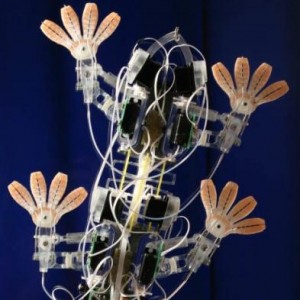The memristor, a circuit element that quite interests me [April 7, 2010 posting], seems to be moving from being a purely electrical engineering term to one that’s used metaphorically to describe biological processes in a way that is transforming my understanding of machine/human (and other animal) interfaces from a science fiction concept to reality.
March 2, 2011 Kate McAlpine wrote an article for the New Scientist which suggested that skin has memristive properties while noting that the same has been said of the brain. From Sweat ducts make skin a memristor,
Synapses, junctions between neurons in the brain, display electrical behaviour that depends on past activity and are said to behave like memristors. This has raised the prospect of using memristors as the basis of an artificial brain.
Now, by re-examining data from the early 1980s on the electrical conductivity of human skin in response to various voltages, Gorm Johnsen and his colleagues at the University of Oslo in Norway have uncovered a more prosaic example of memristive behaviour in nature.
They found that when a negative electrical potential is applied to skin on various parts of the arm, creating a current, that stretch of skin exhibits a low resistance to a subsequent current flowing through the skin. But if the first potential is positive relative to the skin, then a subsequent potential produces a current that meets with a much higher resistance. In other words, the skin has a memory of previous currents. The finding is due to be published in Physical Review E.
The researchers attribute skin’s memristor behaviour to sweat pores.
More recently, there’s been some excitement about a research team in India that’s working with blood so they can eventually create a ‘liquid memristor’. Rachel Courtland wrote a brief item on the ‘blood memristor’ on April 1, 2011 for the IEEE Tech Talk blog,
S.P. Kosta of the Education Campus Changa in Gujarat, India and colleagues have published a paper in the International Journal of Medical Engineering and Informatics showing that human blood changes its electrical resistance depending on how much voltage is applied. It also seems to retain memory of this resistance for at least five minutes.
The team says that makes human blood a memristor: the fourth in the family of fundamental circuit elements that includes the resistor, the capacitor, and the inductor. Proposed in 1971, the memristor’s existence wasn’t proven until 2008, when HP senior fellow Stanley Williams and colleagues demonstrated a memristor device made of doped titanium dioxide.
There was also a March 30, 2011 news item about the Indian research titled, Blood simple circuitry for cyborgs, on Nanowerk, which provided this information,
They [the research team] constructed the laboratory-based biological memristor using a 10 ml test tube filled with human blood held at 37 Celsius into which two electrodes are inserted; appropriate measuring instrumentation was attached. The experimental memristor shows that resistance varies with applied voltage polarity and magnitude and this memory effect is sustained for at least five minutes in the device.
Having demonstrated memristor behavior in blood, the next step was to test that the same behavior would be observed in a device through which blood is flowing. This step was also successful. The next stage will be to develop a micro-channel version of the flow memristor device and to integrate several to carry out particular logic functions. This research is still a long way from an electronic to biological interface, but bodes well for the development of such devices in the future.
Kit Eaton in an April 4, 2011 article (Electronics Made from Human Blood Cells Suggest Cyborg Interfaces, Spark Nightmares) on the Fast Company website gives more details about possible future applications,
Ultimately, the fact that a biological system could be used to interact with a hard semiconductor system could revolutionize biomechanics. That’s because wiring devices like cochlear implants, nerve-triggered artificial limbs and artificial eyeballs into the body at the moment involves a terribly difficult integration of metal wiring–with all the associated risk of infection and rejection. Plus it’s really a very promising first step toward making a cyborg. Countdown to military interest in this tech in 5…4…3…
It should be noted that the team in India is working towards applications in neuroprosthetics. As for the Norwegian team with their ‘sweat duct/skin memristor’, the article did not specify what types of applications, if any, their work might lead to.
As evidenced by the research covered in these news items, the memristor seems to be drifting or, more accurately, developing a second identity/ghost identity as the term is applied to biological processes.
The body as a machine is a notion that’s been around for a while as has the notion of combining the two. The first notion is a metaphor while the second is a staple in science fiction which, in a minor way, has found a home in the real life practice of body hacking where someone implants a magnetic or computer chip into their body (my May 27, 2010 posting). So the memristor becoming a metaphor for certain biological processes doesn’t seem something new but rather the next step in a process that’s well on its way.
Two students at Ryerson University (Toronto, Canada) recently announced that they had developed a brain-controlled prosthetic. From the March 30, 2011 news item on Nanowerk,
Two Ryerson University undergraduate biomedical engineering students are changing the world of medical prosthetics with a newly developed prosthetic arm that is controlled by brain signals. The Artificial Muscle-Operated (AMO) Arm not only enables amputees more range of movement as compared to other prosthetic arms but it allows amputees to avoid invasive surgeries and could potentially save hundreds of thousands of dollars. The AMO Arm is controlled by the user’s brain signals and is powered by ‘artificial muscles’ – simple pneumatic pumps and valves – to create movements. In contrast, traditional prosthetic limbs – which typically offer more limited movements – rely on intricate and expensive electrical and mechanical components.
Developed by third-year student Thiago Caires and second-year student Michal Prywata, the AMO Arm is controlled by the brain and uses compressed air as the main source of power. The digital device makes use of signals in the brain that continue to fire even after a limb is amputated. Users wear a head-set that senses a signal – for example, the thought “up” – and sends it wirelessly to a miniature computer in the arm. The computer then compares the signal to others in a database. The resulting information is sent to the pneumatic system, which in turn, activates the arm to create the correct movement. Simulating the expansion and contraction of real muscles, the system makes use of compressed air from a small, refillable tank in the user’s pocket.
I think what they mean is that the components are not traditionally electrical and mechanical but in fact informed by emerging technologies and the science that supports them. After all, the computer must run on some kind of electricity and brain activity (wireless signals from the brain will be controlling the prosthetic) is often described as electrical. The result is that the human and the machine are effectively made one since the prosthetic arm is controlled as if it were ‘biological’ arm.
On another part of the spectrum, Iraqui artist Wafaa Bilal made headlines recently when he had a camera implanted into the back of his head creating a third eye. Designed to be a one year project, the artist had to remove the camera when he developed an infection at the site of one of the metal posts used to anchor the camera to his head. From the Feb. 11, 2011 BBC news item,
An artist who had a camera implanted into the back of his head has been forced to remove it after his body rejected part of the device.
Iraqi-born Wafaa Bilal had surgery last week to remove one of three posts holding the camera in place as it posed a risk of infection.
The camera had been taking a photo every minute as part of a year-long project.

Wafaa Bilal and camera (image downloaded from BBC website)
(The artist would like to try it again but, in the meantime, has slung the camera around his neck as a substitute.)
In Bilal’s case, the body is being significantly altered as the machine (camera) is implanted in a place (back of head) where no animal has them located.
What I’m getting at with all of this is that at the same time we seem to be expanding the memristor’s meaning from a term used to describe a concept in electrical engineering to include biological processes, we are exploring new ways of integrating machinery into our bodies. In effect our relationships to our bodies and machines are changing and that change can be traced in the language we use to describe ourselves.

